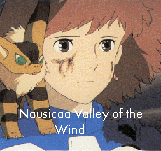

What is Anime? 
This is an introduction to anime, written with the intent to spark an interest to those who haven't got a clue what anime is all about. For those of you in your late thirties or early forties, you probably remember cartoons on TV titled Speed Racer, Astro Boy, or The 8th Man. Did you know that these were imports from Japan? These early cartoon animations from Japan caught the interest of many audiences throughout the world. This is a web site about what anime is today, what makes this art form so unique, what makes it appealing to fans all over the world, and some of my favorite anime.
Anime, pronounced, "annie-may," is a French word meaning animation. Anime on this web site, and among Anime fans is primarily used to describe only Japanese animation. Another term worth mentioning is manga. Manga is the printed Japanese cartoon genre used for comic books and magazines in Japan. Manga is worth mentioning since some anime movies and television series have their origins in manga.
 |  |  |
 characteristic large eyes, overflowing hair, and cutesy looks. I admit there is a
certain predictable style, but after viewing a few movies, you'll notice unique differences from one
animator to the next. It would easy at this point to write off anime as a product of a culture
where conformity is the norm. But upon further observation, you'll find that Japanese anime has
stretched the boundaries of animation, introducing new techniques in color and style, while
broadening the appeal of animation to all age groups, and audiences.
characteristic large eyes, overflowing hair, and cutesy looks. I admit there is a
certain predictable style, but after viewing a few movies, you'll notice unique differences from one
animator to the next. It would easy at this point to write off anime as a product of a culture
where conformity is the norm. But upon further observation, you'll find that Japanese anime has
stretched the boundaries of animation, introducing new techniques in color and style, while
broadening the appeal of animation to all age groups, and audiences.
Animation in Japan is enormously popular. One-third of all printed matter and motion pictures is anime or manga. Similar to the U.S. there is anime for children, then unlike the U.S. there is anime for teenagers, college students, business executives, and to use the expression we use for porn, anime for adults'. When we were kids, we read our comic books, but then like you and me, we grew out of them. I don't mean to offend you comic book collectors out there. I know comic book fans come in all ages in the U.S. and they take their hobby quite seriously, but if one were to visit Japan you'd think that literacy was defined by one's ability to look at cartoon frames. Okay so I'm exaggerating, but not by much!
One of the significant differences between anime and western animation is the abundance  of cinematic techniques used to tell
the story. Anime is characteristic by the prevalent use of tracking shots, long-view establishing
shots, fancy pans, unusual point-of-view "camera angles" and extreme close-ups. In contrast,
most American-produced TV animation tends to thrive in an action-obsessed
middle-distance.(ref. The Complete Anime Guide, by Trish Ledoux and Doug Ranney)
It's as if the American style has confined itself to one standard for television. After all, this is only
kid's stuff right? Only in American movie animation are we beginning to see similar cinematic
techniques with recent Disney movies such as Beauty and Beast, and The Lion
King.
of cinematic techniques used to tell
the story. Anime is characteristic by the prevalent use of tracking shots, long-view establishing
shots, fancy pans, unusual point-of-view "camera angles" and extreme close-ups. In contrast,
most American-produced TV animation tends to thrive in an action-obsessed
middle-distance.(ref. The Complete Anime Guide, by Trish Ledoux and Doug Ranney)
It's as if the American style has confined itself to one standard for television. After all, this is only
kid's stuff right? Only in American movie animation are we beginning to see similar cinematic
techniques with recent Disney movies such as Beauty and Beast, and The Lion
King.
 |  |  |
The popularity of anime in this country can be described as somewhat "underground." Extremely rare exceptions of anime movies have been shown in American movie theaters. But I have noticed some limited anime selections available at Blockbuster video outlets. Independent video rental shops that offer anime are few and far between. Anime appears to have the most following among college and high school students, some which have their anime clubs. Art students that study animation are very much aware of the uniqueness of Japanese animation and are often the only non-Japanese who buy books about anime at a Japanese book store.
To put it simply, anime is a real gem in the world of entertainment and art. Maybe as a result of the limited budgets of movie studios in Japan, the Japanese turned to animation as an alternative to live actor movie making, resulting in a highly refined medium of animation.
Finally, a word of caution, anime, like movies that we have here in the U.S., are both good and bad. Be aware that some anime includes graphic porn, nudity, perversion, and violence to the extreme. Be selective if you're getting anime for your kids and read the warning labels. Don't be mislead by the cute cartoon looking characters on the box. As a guide, I recommend these links for researching specific anime titles for their content: PARENT'S GUIDE TO ANIME and ALAN TAKAHASHI'S ANIME POCKET GUIDE.